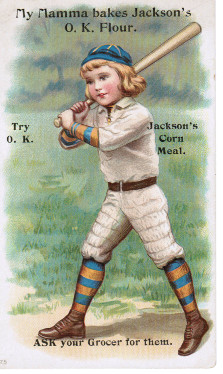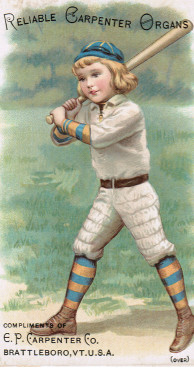Advertising trade cards were one method, in fact, an extremely popular method of advertising. The trade cards were simply pieces of moderately thick paper of varying size. Each trade card usually had an image (often in attractive color) and an advertisement in words of a particular store or product. The trade cards normally used both sides. One side had the attractive image; the reverse side had the ad. But there were exceptions to that rule. Often an ad would appear on the same side as the image. The size of the trade cards vary. Most were rectangular, approximately three by five inches with some smaller and some larger. A small number of these cards appeared in the shape of a pickle, a valentine, a shoe, a person and even a corset. There were unusual cards known as metamorphic ("which changed the image when folded") and mechanical ("which changed the image when pushed").
Excitement, Color and Wonder
These trade cards were distributed free of charge by merchants and salespeople. They were usually not sold or paid for in any manner. While some trade cards appeared before the Civil War (1861-1865), as well as today, the vast majority were printed and distributed during the 1880-1895 era. Hence, we usually associate trade cards with the late 19th century during the Victorian era. There were millions and millions of them in the then basically rural small town America. Since they were often attractive, many families collected and admired them in albums. These trade cards brought an excitement and wonder to many families which is not too hard to understand since many of the media color wonders of 2011 were not present 120 years ago. It is not too uncommon for a collector to find an appealing 20-page album of approximately 170 trade cards in an auction or antique shop. Unfortunately, the trade cards are often glued to the page!
Variety and Exaggeration
Products advertised seem to cover every imaginable possibility including soaps, stoves, baking powder, lawn mowers, shoes, clothing, groceries, coffee, farm equipment, soft drinks, cocoa, sewing machines, thread, sports equipment, and the every-present health remedies and patent medicines. Individual stores which appear on trade cards probably include at least one from every town, large or small, in the United States. (Trade cards appeared in other nations as well.) Some of the brands, such as Armour, Quaker Oats, Hires or Heinz, are still sold. Likewise, a few of the advertised stores are still in business.
Images which appeared on the trade cards also varied. Frequently, the product advertised, such as a farmer's harrowing machine or a domestic sewing machine, would appear. In this way, many of the new wonders of the inventive Americans were introduced to the public. However, attractive men and women as well as angelic or mischievous children probably outnumber the product image cards. At times, a combination of the two above listed images would appear. Example? An attractive girl admiring a stove. Comic scenes were very common and evidently popular. Former presidents, foreign scenes, and animals were among the endless variety of images that appeared on trade cards.
The actual advertising claims were often glowing exaggerations in praise of the product. This, of course, was sometimes misleading and eventually led to government intervention to stop the abuse. At the same time, Herbert Loomis pointed out that "today, it is possible to reconstruct the nineteenth century business life of your city from its advertising cards."
"Stock" Cards and "Private" Cards
There were two types of advertising trade cards, "stock" cards and "private" cards. Frequently, trade cards were made with only an image and no advertisement. These were called "stock" cards. These "stock" cards were widely distributed to many different stores. Each store would then stamp on their particular ad. Consequently, it is possible to find the same trade card image with a different advertisement. For example, a collector can find a trade card advertising furnaces and an identical trade card advertising the Northern Wisconsin State Fair at Chippewa Falls. Another example would be a black trade card entitled "Out! — On a Fly." One card advertises a Connecticut carriage manufacturer. The same image can be found advertising a shoe store in Rhode Island. And this specific card could probably be found with 25 other different advertisers.
|
|
Example of a Stock Card (#207) with Different Advertisers.
Many other trade cards were printed only for a specific advertiser whether a product or a distributor. No other product or store would appear on that card. These were called "private" cards as they advertised only a single specific product or store. Examples would be cards distributed by Max Stadler, a New York clothier, or cards distributed by Chase & Sanborn Coffee.
A BASEBALL CAPTION ALONE ON A TRADE CARD IS USUALLY NOT ENOUGH FOR INCLUSION IN THIS PUBLICATION. A BASEBALL IMAGE OF SOME TYPE (SLIDING PLAYER, A BATTER, OR PIECE OF EQUIPMENT) IS USUALLY NECESSARY. BLOTTERS, BREAD LABELS, SCORECARDS AND CALENDARS ARE NOT TO BE MISTAKEN FOR TRADE CARDS.
Likewise, trade cards are not postcards. Trade cards are not insert cards (sold with the product), which is what most of the early baseball or non-sports cards were. In a relatively few cases, one could acquire a special trade card premium by mailing in a required number of product wrappers.
Collector Categories
Again, there is variety. Trade cards can be collected by:
- Product advertised
- the image which appears on the trade card
- a specific artist or publisher
Examples of the first type of collection would be baking powder, coffee, corsets, drinks, perfume, dentistry, machinery, soaps, starch, or spectacles. Examples of the second type of collection would be animals, cats, blacks, ships, political personalities, toys, Santa Claus — and baseball. An example of an artist would be Palmer Cox. Publishers were many. M. F. Tobin, located in New York, and Forbes Co. of Boston would be two examples.
Baseball trade cards almost always come under the second category. Baseball trade card collectors were usually concerned with the image, not the advertisement. (There are a few exceptions to this rule such as sets H 804-31 and H 804-37. These non-baseball images have double-meaning descriptive titles, which are applicable to baseball.) To give specific examples, a trade card with a baseball theme advertises a washing machine. Another baseball trade card advertises carriages, a third advertises coffee, a fourth advertises liquor at a specific store. These specific advertised products are almost irrelevant, certainly secondary, to the baseball trade card collector. It is the image on the card that gets primary consideration. When baseball trade card collectors meet, they do not say, "I have a baseball trade card with a washing machine advertisement."

